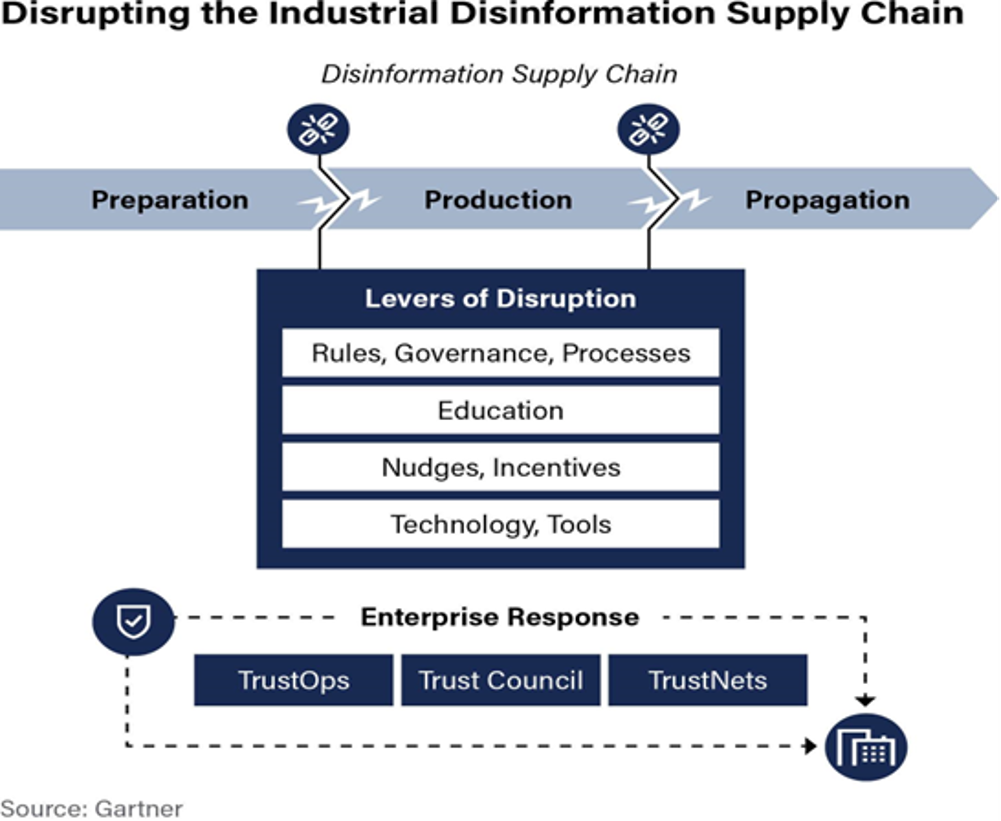Listen to the article
Enterprises to Spend Over $30 Billion Fighting Information Threats by 2028
A significant shift in corporate budget allocations is underway as enterprises prepare to defend themselves against the growing threat of false information. According to a new book by Gartner, companies worldwide will spend more than $30 billion combating misinformation and disinformation by 2028, with approximately 10% of marketing and cybersecurity budgets being redirected toward these efforts.
The mounting concern comes as organizations face an increasingly sophisticated landscape of digital threats, including deepfakes, AI-generated content, phishing attempts, and various forms of data manipulation that can damage brand reputation, compromise security, or mislead stakeholders.
Gartner’s 2024 survey of 200 senior business and technology executives underscores the urgency of the situation, revealing that 72% of respondents identified misinformation, disinformation, and malinformation as “very” or “relatively important” issues for their executive committees to address.
“The lack of reliable information needs to be seen as a meta-issue that compromises everyone’s ability to understand and deal with all other issues,” explains Andrew Frank, VP Analyst in the Gartner for Marketing Leaders practice and co-author of “World Without Truth,” which details these findings.
The problem is expected to intensify as technology evolves. Dave Aron, VP Analyst and Gartner Fellow in the Gartner for High Tech Leaders and Providers practice, who co-authored the book, notes that “the disinformation threat will continue to grow, fuelled by increasingly elaborate uses of synthetic reality, behavioural science and digital media.” Despite this troubling forecast, Aron emphasizes that “there are concrete steps that organisations can take to marginalise the impact and track new threat vectors.”
Among the key recommendations outlined in the book is the formation of dedicated “Trust Councils” within organizations. These cross-functional bodies would include representatives from various departments and be led by C-suite executives from communications, IT, finance, legal, HR, and marketing. The collaborative approach recognizes that information integrity challenges cut across traditional organizational boundaries.
The authors also propose four macro strategies to counter disinformation: implementing effective rules, governance, and processes; providing education to stakeholders; creating behavioral nudges and incentives that promote information integrity; and deploying appropriate technology and tools.
This substantial projected spending reflects the growing recognition among corporate leaders that information integrity is not merely a public relations concern but a fundamental business risk that affects operations, customer trust, and even share price. As generative AI technologies become more accessible and sophisticated, the ability to create convincing fake content has democratized, placing even the most careful organizations at risk.
The financial services sector appears particularly vulnerable, as false information about banking stability or investment opportunities can trigger market volatility and erode customer confidence. Similarly, healthcare organizations face challenges from health misinformation that can undermine public health initiatives or damage institutional credibility.
For technology companies that provide information services or platforms, the stakes are especially high as they navigate the tension between facilitating open communication and preventing the spread of harmful misinformation.
Industry analysts note that this projected $30 billion market has already spurred innovation, with numerous startups developing AI-powered detection tools, blockchain-based verification systems, and digital content authentication solutions. Established cybersecurity and marketing technology vendors are also expanding their offerings to address these emerging threats.
As organizations allocate significant resources to combat false information, many are recognizing that technological solutions alone will be insufficient. The most effective approaches will likely combine advanced detection tools with human expertise, organizational vigilance, and proactive communication strategies to build resilience against the growing tide of misinformation.
Verify This Yourself
Use these professional tools to fact-check and investigate claims independently
Reverse Image Search
Check if this image has been used elsewhere or in different contexts
Ask Our AI About This Claim
Get instant answers with web-powered AI analysis
Related Fact-Checks
See what other fact-checkers have said about similar claims
Want More Verification Tools?
Access our full suite of professional disinformation monitoring and investigation tools




8 Comments
The $30 billion forecast for disinformation mitigation efforts sounds significant. I’m curious to see how enterprises balance these defensive investments with other digital transformation and cybersecurity priorities in the coming years.
You raise a good point. Striking the right balance between defensive and proactive initiatives will be crucial as the disinformation landscape continues to evolve.
As the disinformation landscape becomes more complex, I’m curious to see what specific strategies and technologies companies will deploy to stay ahead of emerging threats. Collaboration across sectors may also be key to developing comprehensive solutions.
The trust economy represents both an opportunity and a vulnerability for businesses. Effective disinformation defense will require a combination of technical, analytical, and communication capabilities to safeguard brand reputation and stakeholder confidence.
This article highlights the systemic challenges that organizations face in an era of heightened information risks. Developing the right mix of technological, operational, and cultural solutions will be vital to building trust and resilience.
It’s interesting to see the scale of investment that Gartner is forecasting for disinformation mitigation. This speaks to the growing materiality of information risks and the imperative for enterprises to prioritize trust and transparency.
It’s concerning to see the degree to which misinformation has become an executive-level concern. The growing sophistication of digital threats like deepfakes underscores the need for robust, multifaceted strategies to protect information integrity.
Interesting to see the growing focus on combating disinformation. As the trust economy expands, companies will need to invest heavily in safeguarding their brands and stakeholders from the threats of false information.